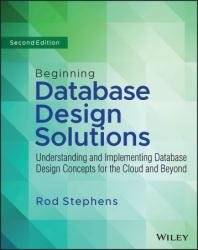Beginning Database Design Solutions: Understanding and Implementing Database Design Concepts for the Cloud and Beyond, 2nd Edition
- Добавил: literator
- Дата: 28-02-2023, 10:47
- Комментариев: 0
 Название: Beginning Database Design Solutions: Understanding and Implementing Database Design Concepts for the Cloud and Beyond, 2nd Edition
Название: Beginning Database Design Solutions: Understanding and Implementing Database Design Concepts for the Cloud and Beyond, 2nd EditionАвтор: Rod Stephens
Издательство: Wiley
Год: 2023
Страниц: 739
Язык: английский
Формат: pdf (true)
Размер: 27.8 MB
A concise introduction to database design concepts, methods, and techniques in and out of the cloud.
In the newly revised second edition of Beginning Database Design Solutions: Understanding and Implementing Database Design Concepts for the Cloud and Beyond, Second Edition , award-winning programming instructor and mathematician Rod Stephens delivers an easy-to-understand guide to designing and implementing databases both in and out of the cloud. Without assuming any prior database design knowledge, the author walks you through the steps you’ll need to take to understand, analyze, design, and build databases.
This book provides the tools you need to design a database. It explains how to determine what should go in a database and how a database should be organized to ensure data integrity and a reasonable level of performance. It explains techniques for designing a database that is strong enough to store data safely and consistently, flexible enough to allow the application to retrieve the data it needs quickly and reliably, and adaptable enough to accommodate a reasonable amount of change.
In the book, you’ll find clear coverage of foundational database concepts along with hands-on examples that help you practice important techniques so you can apply them to your own database designs, as well as:
Downloadable source code that illustrates the concepts discussed in the book
Best practices for reliable, platform-agnostic database design
Strategies for digital transformation driven by universally accessible database design
What you need to use this book
This book explains database design. It tells how to determine what should go in a database and how the database should be structured to give the best results. This book does not focus on actually creating the database. The details of database construction are different for different database tools, so to remain as generally useful as possible, this book doesn’t concentrate on any particular database system. You can apply most of the techniques described here equally to whatever database tool you use, whether it’s MariaDB, PostgreSQL, MongoDB, SQL Server, or some other database product.
To remain database-neutral, most of the book does not assume you are using a particular database, so you don’t need any particular software or hardware. To work through the exercises, all you need is a pencil and some paper. You are welcome to type solutions into your computer if you like, but you may actually find working with pencil and paper easier than using a graphical design tool to draw pictures, at least until you are comfortable with database design and are ready to pick a computerized design tool.
Chapters 16 through 25 build example databases using particular database offerings, so their material is tied to the databases that they demonstrate. Chapter 15, “Example Overview,” introduces those chapters and lists the databases that they use. To experiment with the SQL database language described in Chapter 26, “Introduction to SQL,” and Chapter 27, “Building Databases with SQL Scripts,” you need any database product that supports SQL (that includes pretty much all relational databases) running on any operating system.
Chapter 3, “NoSQL Overview,” explains the basics of NoSQL databases, which are growing quickly in popularity. Those databases include document, key- value, column- oriented, and graph databases.Both relational and NoSQL databases can run either locally or in the cloud, but many NoSQL databases are more cloud- oriented, largely because they are newer technology so they’re cloud- native.
Chapter 15, “Example Overview,” provides a roadmap for the chapters that follow. It tells which chapters use which databases and how to get the most out of those chapters. Chapters 16 through 25 come in pairs, with the first describing an example in Python and the second describing a similar (although not always identical) program in C#.
Chapters 16 and 17 describe examples that use the popular MariaDB column- oriented relational database running on the local machine.
Chapters 18 and 19 demonstrate the (also popular) PostgreSQL database, also running on the local machine.
Who this book is for:
This book is intended for IT professionals and students who want to learn how to design, analyze, and understand databases. The material will benefit those who want a better high- level understanding of databases such as proposal managers, architects, project managers, and even customers. The material will also benefit those who will actually design, build, and work with databases such as database designers, database administrators, and programmers. In many projects, these roles overlap so the same person may be responsible for working on the proposal, managing part of the project, and designing and creating the database. This book is aimed at readers of all experience levels. It does not assume that you have any previous experience with databases or programs that use them. It doesn’t even assume that you have experience with computers. All you really need is a willingness and desire to learn.
Скачать Beginning Database Design Solutions: Understanding and Implementing Database Design Concepts for the Cloud and Beyond, 2nd Edition
[related-news] [/related-news]
Внимание
Уважаемый посетитель, Вы зашли на сайт как незарегистрированный пользователь.
Мы рекомендуем Вам зарегистрироваться либо войти на сайт под своим именем.
Уважаемый посетитель, Вы зашли на сайт как незарегистрированный пользователь.
Мы рекомендуем Вам зарегистрироваться либо войти на сайт под своим именем.
